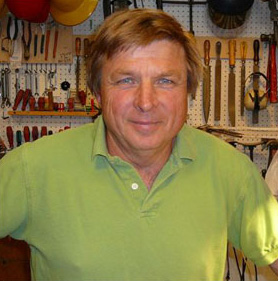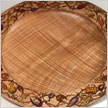 Demonstration
on August 12, 2011
Demonstration
on August 12, 2011
Michael Hosaluk Place: Jim’s Shop
Brochure at this link.

Michael Hosaluk lives and has his studio just outside Saskatoon, Saskatchewan, Canada. Born in 1954, in Invernay, Saskatchewan.
Michael is self-taught and has become internationally recognized as one of the world's most creative turners.
 His work
covers a wide range of objects and materials including functional
vessels, furniture and sculptured pieces. His work is both
humorous and elegant.
His work
covers a wide range of objects and materials including functional
vessels, furniture and sculptured pieces. His work is both
humorous and elegant.

Michael demoed a wide combination of spindle and bowl turning tricks, bending wood, unusual boxes, and turning a translucent bowl. He used a wide range of tools with ease and skill. Thanks also to Jim for hosting, and to Dan and others for setting up and supporting the event.
Description with Videos:
Spindle Turning
In this video he describes how he became a professional wood turner. He demonstrates how to do spindle turning at a high rate, with the use of the skew chisel, roughing gouge and a 1/2 detail gouge.
Off-Center Turning
In this video he describes how to do off-center turning. He used the 1/2in Thompson detail gouge extensively here.
Honing: to Sharpen Tools
In this video he shows how to sharpen tools using honing tools. He sharpened his tools quite often, mostly using honing as descrived here, about once every 2 minutes of turning.
Small Hallow Form
In this video he demonstrates how to do a small hallow form using tools quite simple and reminiscent of the Ellsworth tools. This piece of burl was a good challenge.
Thin Bowl Turning
In this video he demonstrates how to do a very thin green bowl using a 3/8 and 1/2 in bowl gouges. Having a thin bead at the top rim, he kept turning the bowl thinner, even using an old scraper in a shear scrapping mode.
Turning of a Ladle with Bent Handle
In this video he demonstrates how to turn a ladle out of one piece of wood and with the aid of a microwave, to bend the handle.
Making a Unusual Box
He demonstrated the making of a unusal shaped box, more of a display piece than a functional piece. His approach was to take a long piece of wood, about 15-20 in long, and cut it in half after making it into a cyclinder. He then hallowed out a shape in each half that was not rectangular, but represented the shape the outside would eventually take. After finishing the cuts and sanding on each outside, he went to the bandsaw and cut what could be desribed as wedges.
Sanding the end grain to flat, he then "sized the grain," whihc meant he coated it with a 50:50 mix of Titebond glue and water and allowed to dry. Using the full strenght Titebond he then put each piece together to allow the shape of a snake or curve to become apparent.